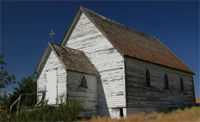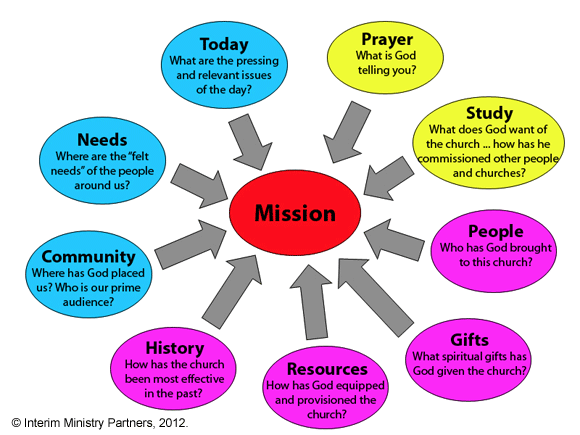Addressing a disheartened and apathetic band of believers on the verge of throwing in the towel, the writer of Hebrews urges them to "remember those earlier days after you had received the light" (Hebrews 10:32). He urges them to recall how they had joyfully stood firm, side by side, in the face of great adversity. To reignite their passion, he invites them to recall God's unfailing faithfulness to his people, demonstrated in their life together.
In the book of Revelation, Jesus charges the church in Ephesus with losing their love for him (Revelation 2:1-7). He implores them to "think about where you have fallen from, and then turn back and do as you did at first" (Revelation 2:5).
These Bible-times congregations are not unique. Most churches in existence today were begun by a group of faithful, visionary leaders who felt a compelling need for the ministry they were beginning. At the outset, enthusiasm and optimism ran sky high. "Impossible" was just another 10-letter-word. But over time, the fervor cools. A structured routine develops as an aid to organization and efficiency. If kept unvaried and unquestioned, the routine is eventually promoted from aide to master and finally to idol. The compelling vision of the church's founders recedes into the background as members scurry to maintain the routine.
 Robert Dale's book To Dream Again has become somewhat of a classic. In this book, he details this process. He suggests that churches follow a predictable bell-shaped life cycle from birth to eventual death. On the upward side of the curve are the stages of dreaming, affirming core beliefs, setting goals, and developing structure. Effective ministry is the stage at the peak-the hard-won result of efforts invested in the earlier stages.. On the downward half of the curve lie the stages of nostalgia, questioning, polarization, and dropout-followed by death.
Robert Dale's book To Dream Again has become somewhat of a classic. In this book, he details this process. He suggests that churches follow a predictable bell-shaped life cycle from birth to eventual death. On the upward side of the curve are the stages of dreaming, affirming core beliefs, setting goals, and developing structure. Effective ministry is the stage at the peak-the hard-won result of efforts invested in the earlier stages.. On the downward half of the curve lie the stages of nostalgia, questioning, polarization, and dropout-followed by death.
Dale's book sets forth the recovery strategy for churches who find themselves on the downside of the life cycle. They must dig into their history to rediscover the dreams of their founding members. This process may be especially important for churches that are in transition between lead ministers. It is typical for the loss of a minister to surface previously-hidden questioning and polarization within the ranks of the membership. Significant numbers of people may drop out unless something is done to reignite their love for the church and its work.
Wise leaders will learn to ask some important questions about the history of the church:
- When did this congregation begin?
- Who was involved in its inception?
- What conditions existed in the community at the time?
- What compelling needs did the founders see that justified planting a new church?
- What hopes and dreams did they have for the future of the congregation?
Answers to these questions can be enlightening to a leadership trying to discern God's call for their church. Of course, it is a mistake to try to re-impose the founders' dreams-unmodified-on a present-day congregation. Rather, leaders need to discern how that original dream applies to the circumstances and challenges of the present day.
Another set of questions centers around the "effective ministry" stage of the church's life cycle.
- When was this church at its best?
- When was its work most effective?
- When were families being added to the church with regularity?
- When was morale high?
Once that era has been identified, leaders can ask other important questions:
- What compelling vision was in place during that time?
- What strategies did they employ that proved to be effective?
- What kinds of people were they able to reach, and why?
Again, the purpose is not to slavishly recreate the forms of the congregation's golden era, but to recapture their devotion to the godly functions of the church. What is being sought is a record of God's movements in and through the congregation. In what ways has God typically used us? Which of the biblical functions of the church has he enabled us to fulfill in a special way? How has God spread blessings to our community through us?
 God can speak to your church through history. Certainly, churches can and should evolve and mature. History must not become a cage that traps churches in endless cycles of trying to resurrect old glory. However, history can point back to God's mission for your church, highlight when your church was functioning squarely within the will of God, and show you a path for reconnecting with your "first love" and best efforts. By learning from the past, you might well discover how to navigate in the future.
God can speak to your church through history. Certainly, churches can and should evolve and mature. History must not become a cage that traps churches in endless cycles of trying to resurrect old glory. However, history can point back to God's mission for your church, highlight when your church was functioning squarely within the will of God, and show you a path for reconnecting with your "first love" and best efforts. By learning from the past, you might well discover how to navigate in the future.
Churches in the doldrums may need a good history lesson. Some of the most valuable resources in your church may be the old-timers, the folks who are too often seen as cantankerous obstacles to progress. In reality, the key to progress may well be to sit down with some of the early members and have them share their stories. As you listen - really listen - you may be surprised to discover a way to dream again.
This is part of an ongoing series of messages from the partners at Interim Ministry Partners: Discovering our Mission as God's Church. These messages are based on a proven set of moves a congregation needs to make as it is transitioning in its preaching leadership and wants to focus on its mission. The following chart illustrates the key moves and the direction each of these moves should help the congregation move. You can find this series listed in our Kingdom Leadership section of Heartlight.org

 "History and Mission" by Mark Frost is licensed under a Creative Commons License. Heartlight encourages you to share this material with others in church bulletins, personal emails, and other non-commercial uses. Please see our Usage Guidelines for more information.
"History and Mission" by Mark Frost is licensed under a Creative Commons License. Heartlight encourages you to share this material with others in church bulletins, personal emails, and other non-commercial uses. Please see our Usage Guidelines for more information.











Comments
Have thoughts on this article? Leave a comment